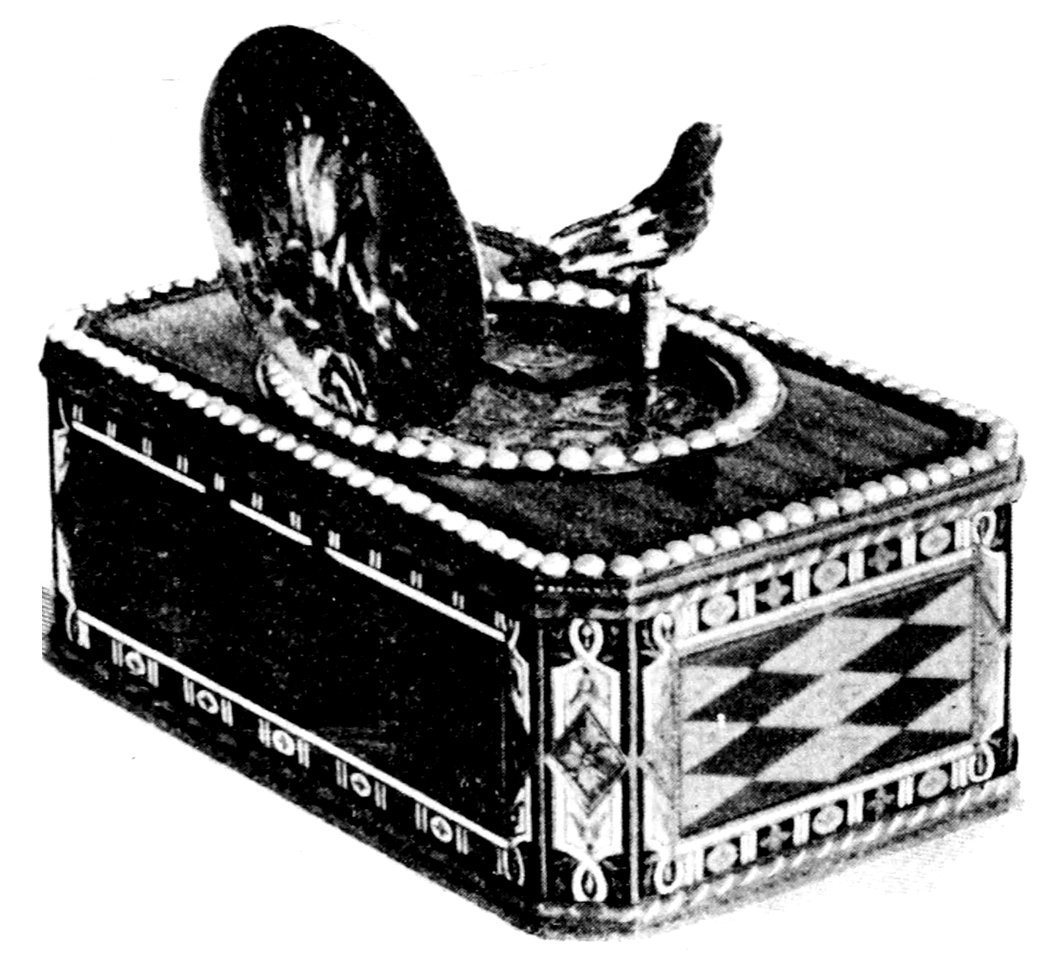
Singing Bird Box
Signed “Jaquet-Droz and Leschot London”
(from an old engraving)
Actually in the collection of Mr Luis Dubois-Favre
Le Loele, Switzerland.
The Project Gutenberg EBook of A few remarks concerning makers of Singing
Bird boxes of the Eighteenth and Nineteenth Centuries, by Georges
Constantin Pélissier
This eBook is for the use of anyone anywhere in the United States and
most other parts of the world at no cost and with almost no restrictions
whatsoever. You may copy it, give it away or re-use it under the terms
of the Project Gutenberg License included with this eBook or online at
www.gutenberg.org. If you are not located in the United States, you
will have to check the laws of the country where you are located before
using this ebook.
Title: A few remarks concerning makers of Singing Bird boxes of the
Eighteenth and Nineteenth Centuries
Author: Georges Constantin Pélissier
Release Date: December 07, 2020 [EBook #63983]
Language: English
Character set encoding: UTF-8
Produced by: Richard Tonsing, deaurider, and the Online Distributed
Proofreading Team at https://www.pgdp.net (This file was
produced from images generously made available by The Internet
Archive)
*** START OF THE PROJECT GUTENBERG EBOOK A FEW REMARKS CONCERNING MAKERS OF
SINGING BIRD BOXES OF THE EIGHTEENTH AND NINETEENTH CENTURIES ***
Transcriber’s Note:
The cover image was created by the transcriber and is placed in the public domain.
The invention of these marvellous pieces of mechanism dates from about the middle of the eighteenth century.
When they first appeared they were so highly praised that they were immediately bought by the principal Courts of Europe, and it is only later, at the beginning of the nineteenth century, that the very high class of people could acquire the rare specimen that came now and then on the market.—
The characteristic of the antique singing bird snuff boxes, is that the bird, when singing and moving its wings, opens its beak, when turning the head. It is unfortunate to say, that modern watchmakers have not acquired the skilfulness of their predecessors, and that in modern boxes this triple movement can no more be obtained. This is, as a matter of fact, one of the first means of distinguishing an antique bird box, from a modern one.—

Singing Bird Box
Signed “Jaquet-Droz and Leschot London”
(from an old engraving)
Actually in the collection of Mr Luis Dubois-Favre
Le Loele, Switzerland.
The discovery of these small curious pieces of mechanism is due to a Swiss watchmaker whose name is
This wonderful artist was born at La Chaux de Fonds (Switzerland) on the 28th of July 1721. His parents, rich peasants, seeing the great dispositions of their Child for Study, had projected to make a clergyman of him, and consequently sent him to study theology at Neuchâtel.
During his holidays, which he used to spend at one of his sisters, who, having abandoned the old industry of this city, which was lacemaking, married a watchmaker, the young Peter was deeply interested in all mechanics, and spent all his time working at his sister’s workshop. He soon became so industrious that everybody induced him to leave Theology and become a watchmaker.
His improvement astonished even the oldest and very best workmen, and he soon became their master.
It was about the year 1752, the year of his marriage, that he made his first singing bird,—in a gold snuff box, the bird appearing and singing when opening the box to take snuff.—
His fame became so universal, that in 1758 he was summoned by the King of Spain, for whom he worked, and made such marvellous automata that the Santa Inquisition, at a certain time wanted to condemn him as a “Sorcier,” a very terrible charge at that time.
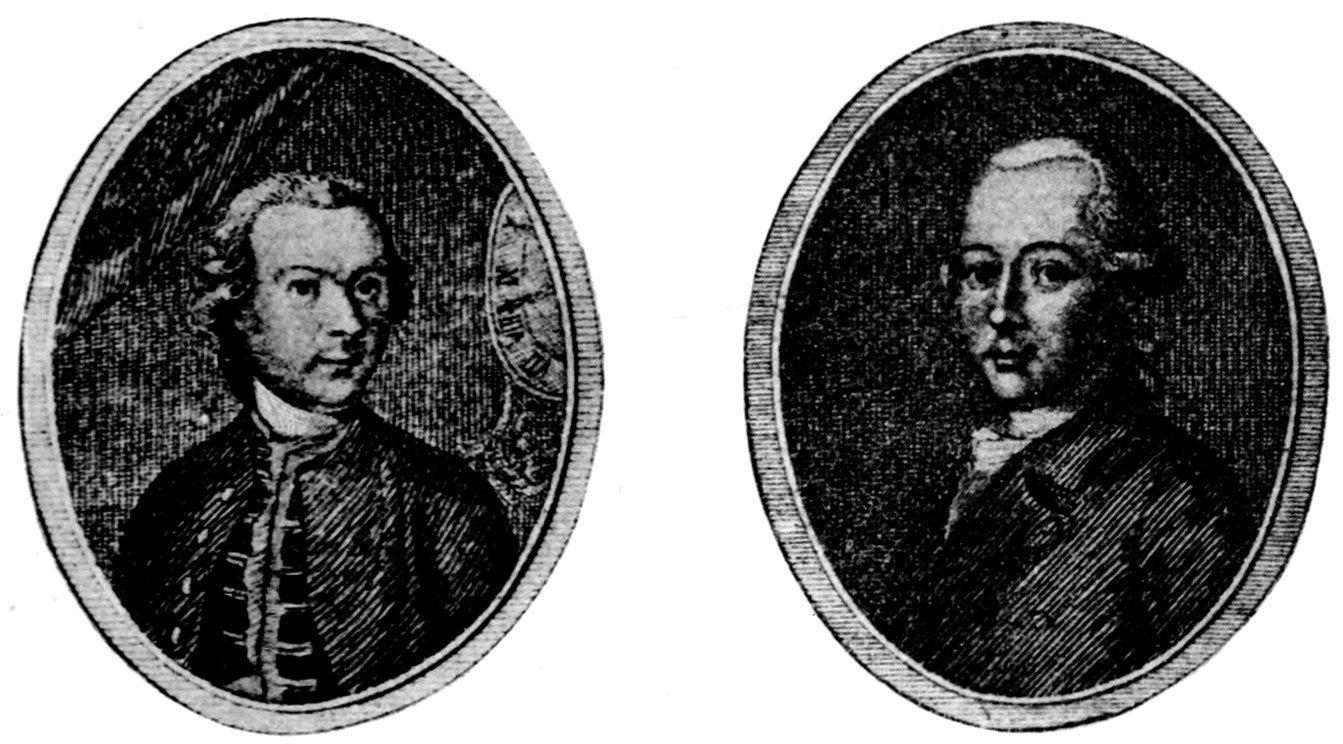
Pierre Jaquet-Droz Henri Louis Jaquet-Droz
From a design by Girardet (1795)
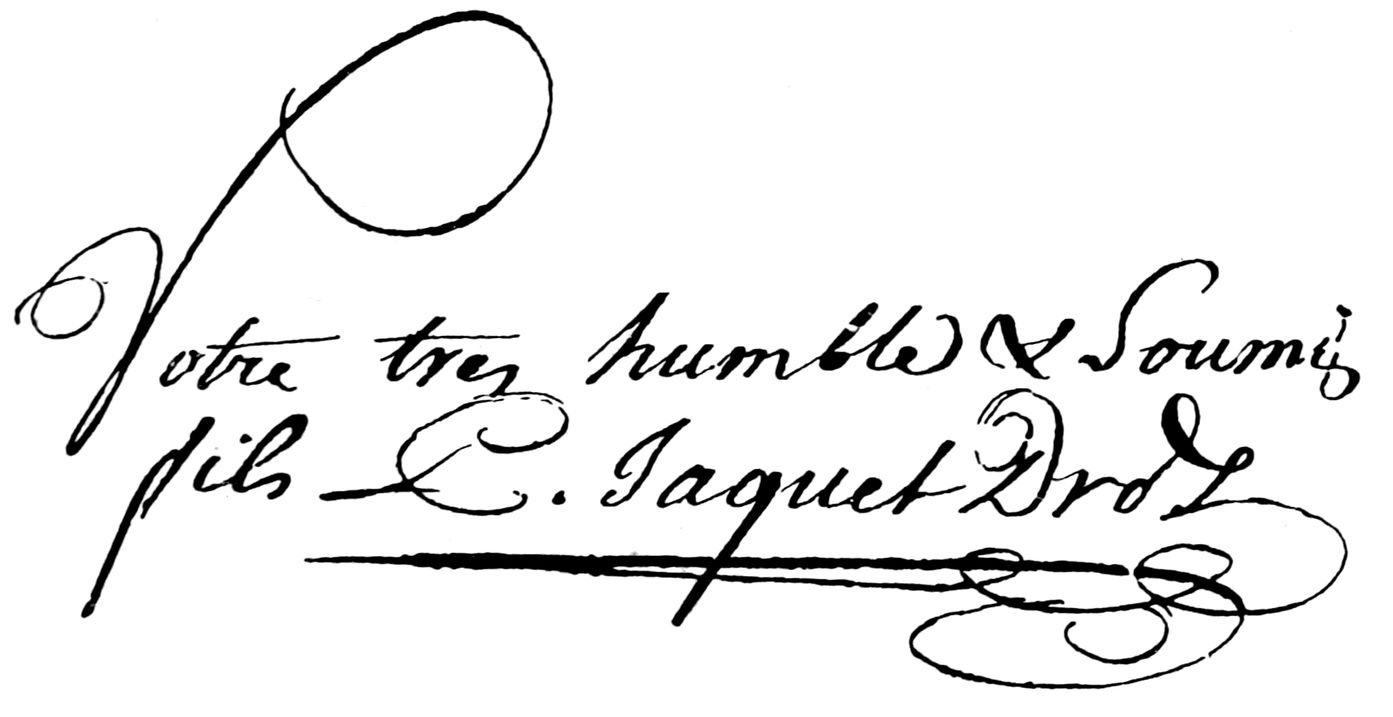
Signature of Pierre Jaquet-Droz
The King of Spain having died soon afterwards, he returned to La Chaux de Fonds in 1759. In 1767 he sent his son Henri Louis Jaquet-Droz to France, where he studied mathematics in the University of Nancy (Lorraine) and on his return, three years later, he took him into partnership with him.—
The productions of the father and the son then attained the utmost of perfection. In collaboration with his father and of the very best workmen of that time, Leschot, Maillardet, and Jean Pierre Droz (who became Director of the Paris Mint) Henry Louis Jaquet-Droz, made the most marvellous pieces that have ever been produced;—the Designer, the Clavecin Player, the Young Writer, wonderful specimens which still can be seen in perfect condition and still working in the Museum of Neuchâtel.
In 1774, Henry Louis Jaquet-Droz came to Paris and was received with the greatest favor by King Louis XVIth and especially by the young Queen Marie Antoinette, who had ascended to the Throne the same year, who was particularly and deeply interested in his Works after she had seen the “Designer” by pressing a button, making her own portrait and that of the King’s on a blank sheet of paper placed before the instrument.—(This can still be seen in Neuchâtel every month, and also at any time by payment of a fee.)
Jaquet-Droz afterwards went to England, where he was received by King George III.
It is in England that he made most of the singing bird boxes known of his construction.
He started a workshop in London where the most important and interesting pieces in complicated watches and boxes were made,—which after were to be found in almost every part of the world, even in China, as in 1860 on the occasion of the pillage of the Summer Palace of the Emperor of China, many pieces signed by Jaquet-Droz were discovered and brought back to Europe.
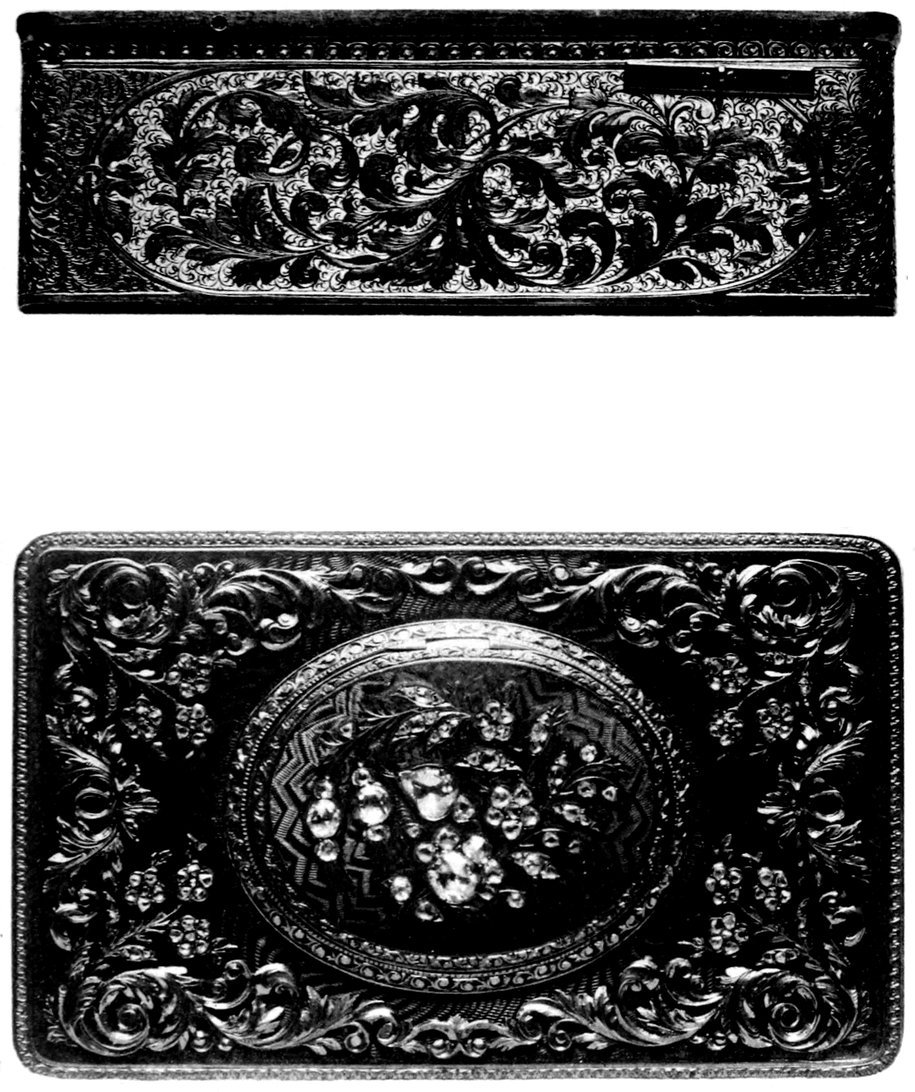
Gold, enamel and diamond Bird Box by “Bruguier—the Father”
Collection Tiffany & Co., New York
Every one is aware how much works of this nature are appreciated by the Chinese in general, and the fact that several of Jaquet-Droz’s productions were in possession of the Emperor of China is a sufficient proof of the genius of this artisan.—
Peter Jaquet-Droz died on the 28th November 1790 aged 69 years.—
His son Henri Louis Jaquet-Droz whose health had always been delicate died in Naples, where he had gone for a cure, on the 15th November 1791 aged 39 years.—
Little is known of the life and history of other manufacturers of Singing Bird boxes, as they were artisans in a very small way of business, working quite by themselves, in villages surrounding Geneva.—
The following is all we could find about them.——
Charles Bruguier, is better known under the name of Bruguier le Père (Bruguier the Father), was born in about 1750 and died in 1830. He had two sons: 1º Jacques Bruguier whose date of birth and death are unknown, and 2º Charles Bruguier known as Charles Abraham Bruguier or “Bruguier-the-Son” born in 1788 and dead in 1862, leaving his brother and his son who died in 1886, thus ending this family.
The three Bruguiers made very elaborate and fine bird boxes which they marked with their full name, and a number indicating date of same.
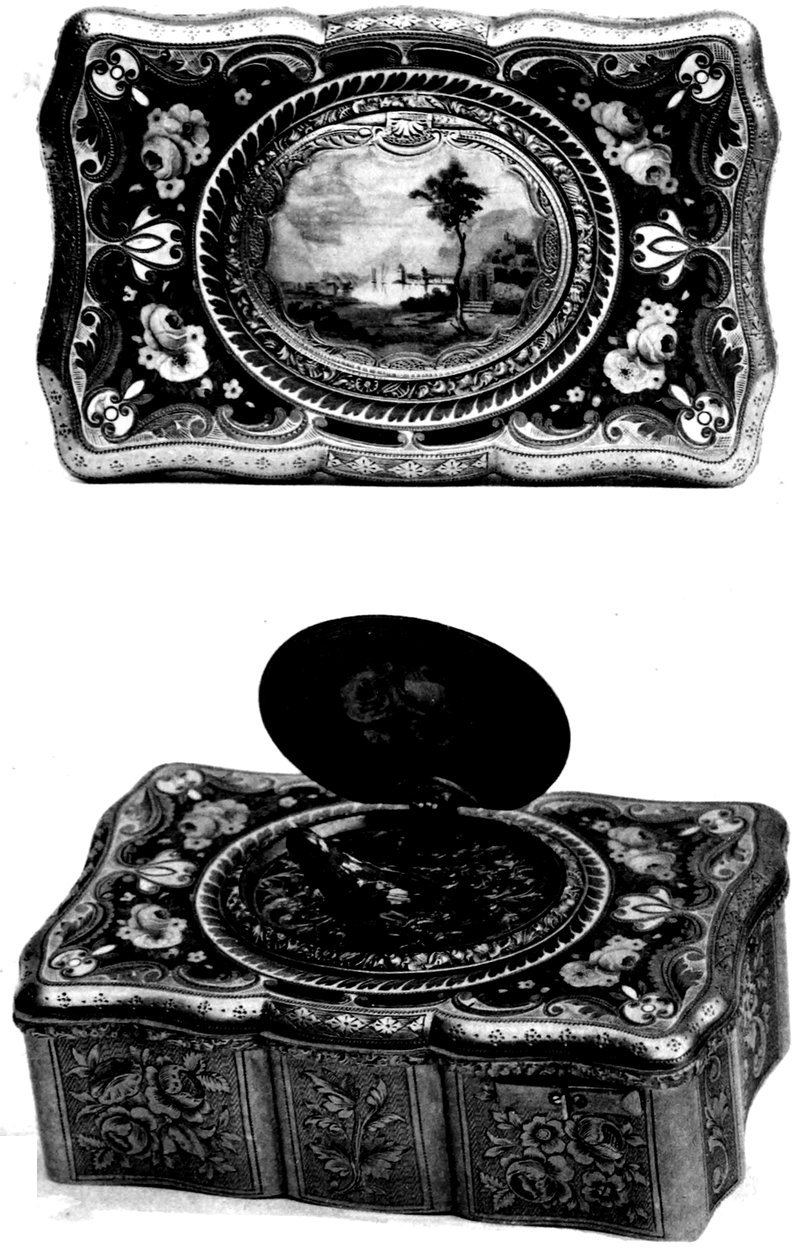
Silver gilt and enamel Bird Box signed “Charles Bruguier, Rue des Pâquis 5, Genève”
(Charles Bruguier-the-Son’s own handwriting)
Collection Tiffany & Co., New York
This artist lived about at the same time as Bruguier the Father, that is from about 1750 to 1827, but the exact dates of his birth and death are uncertain.
The pieces of Bruguier du Grand Pré, are generally smaller than those of Bruguier the Father—and are considered by connoisseurs as superior. He lived in the surroundings of Geneva, and marked his pieces with his mark and a number indicating the date of manufacture.
Pierre Rochat was born in the year 1780, he lived with his two sons Ami Napoléon Rochat and Louis Rochat, at a place called “Chez Meillau” au Brassus, Valley of the Lake of Joux, Switzerland. He devoted himself with his sons to the manufacture of Geneva music boxes and other small pieces of the same kind,—most of them hidden in various small objects, such as snuff boxes, bonbon boxes etc.
After having lost his fortune in building speculations, the Rochat family came to Geneva in 1815 and prospered again by making most curious marvels of small mechanics, which were highly appreciated by the connoisseurs and sold to the principal courts of Europe.—
Pierre Rochat had been for some time in the employ of Jaquet-Droz.—
Ami Napoléon Rochat the eldest son, made a speciality of the singing bird boxes which established the reputation of the name of Rochat all over the world.—
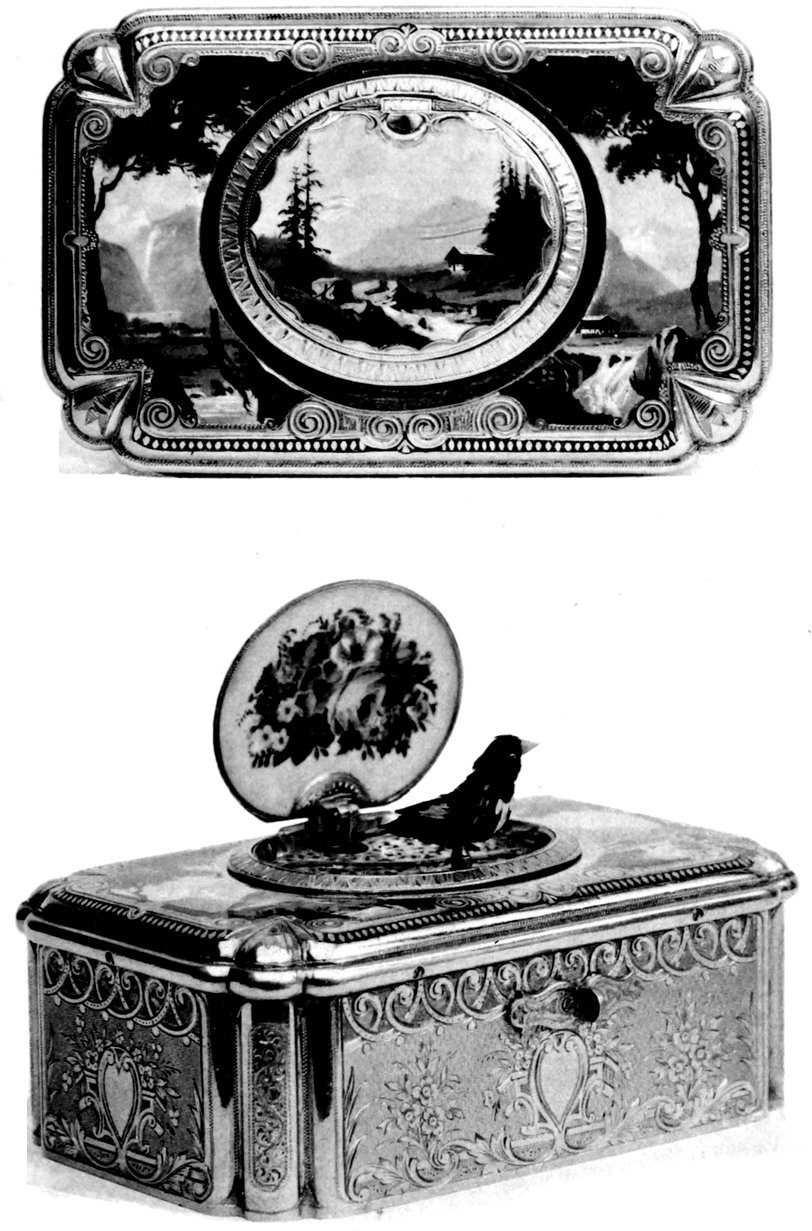
Silver gilt and enamel singing Bird Box by Charles Bruguier
Collection Tiffany & Co., New York
The work was absolutely perfect, especially the singing and extreme complication and smallness of the mechanism the bird opening its beak and turning its head when singing.
Louis Rochat the second son was in that line even better than his brother; he conceived and executed the most curious and complicated pieces, which have never been imitated since; for instance singing bird watches and the famous Singing bird Pistols, where a bird appeared and sang out of the barrel when pressing the trigger. A very rare specimen of such pistol is in the Bernard Frank collection in Paris, one of the most renowned collections in Paris.—
In 1829 Louis Rochat made a curious and complicated clock, for which he was awarded by a special diploma, and appointed “Companion of the Watchmakers and scientists of the city of Geneva.”—
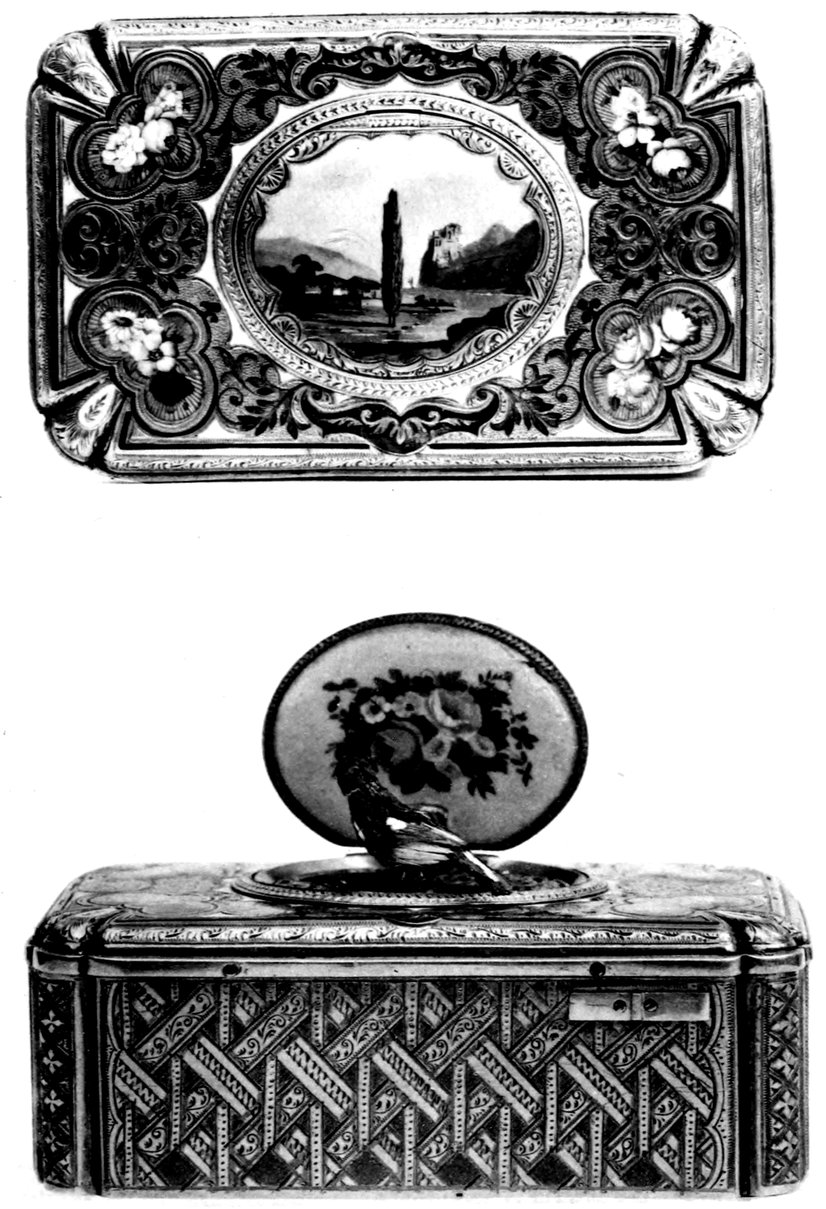
Silver gilt and enamel Bird Box by Charles Bruguier-the-Son
Collection Tiffany & Co., New York
This artist was born in 1810 and died in 1902.
He made singing bird boxes of the same size and grade of work as the Bruguiers.
They are just as well quoted by connoisseurs as these, but they are very difficult to recognize as he did not mark nor number them.—
To these different names it is only right that we should add that of the Maillardet Family:
Jean David Maillardet and Auguste Maillardet who have made many small mechanical works, after their collaboration with the Jaquet-Droz.
Unfortunately they very seldom signed their pieces, and the documents respecting their biography are consequently inexistent.
Some of their works have anyhow come under our notice, for instance a snuff box which belongs to a private collection of Neuchâtel and is loaned to the Museum of La Chaux de Fonds. The origin of that piece has been traced as it has been won in a lottery, the curious advertisement concerning which (dated 27 March 1847) is still to be seen in the Museum of La Chaux de Fonds. The number of tickets issued for the lottery was 2700, each of which was valued at “3 Francs of France.” This snuff box, bearing No 5, was valued at the time at 420 “Francs of France” (what should its value be now)?
The second piece is a “Magician” executing all sorts of tricks, which is still exhibited in the Museum of La Chaux de Fonds.

*** END OF THE PROJECT GUTENBERG EBOOK A FEW REMARKS CONCERNING MAKERS OF
SINGING BIRD BOXES OF THE EIGHTEENTH AND NINETEENTH CENTURIES ***
This file should be named 63983-h.htm or 63983-h.zip
This and all associated files of various formats will be found in:
http://www.gutenberg.org/6/3/9/8/63983/
Updated editions will replace the previous one--the old editions will
be renamed.
Creating the works from print editions not protected by U.S. copyright
law means that no one owns a United States copyright in these works,
so the Foundation (and you!) can copy and distribute it in the United
States without permission and without paying copyright
royalties. Special rules, set forth in the General Terms of Use part
of this license, apply to copying and distributing Project
Gutenberg-tm electronic works to protect the PROJECT GUTENBERG-tm
concept and trademark. Project Gutenberg is a registered trademark,
and may not be used if you charge for the eBooks, unless you receive
specific permission. If you do not charge anything for copies of this
eBook, complying with the rules is very easy. You may use this eBook
for nearly any purpose such as creation of derivative works, reports,
performances and research. They may be modified and printed and given
away--you may do practically ANYTHING in the United States with eBooks
not protected by U.S. copyright law. Redistribution is subject to the
trademark license, especially commercial redistribution.
START: FULL LICENSE
THE FULL PROJECT GUTENBERG LICENSE
PLEASE READ THIS BEFORE YOU DISTRIBUTE OR USE THIS WORK
To protect the Project Gutenberg-tm mission of promoting the free
distribution of electronic works, by using or distributing this work
(or any other work associated in any way with the phrase "Project
Gutenberg"), you agree to comply with all the terms of the Full
Project Gutenberg-tm License available with this file or online at
www.gutenberg.org/license.
Section 1. General Terms of Use and Redistributing Project
Gutenberg-tm electronic works
1.A. By reading or using any part of this Project Gutenberg-tm
electronic work, you indicate that you have read, understand, agree to
and accept all the terms of this license and intellectual property
(trademark/copyright) agreement. If you do not agree to abide by all
the terms of this agreement, you must cease using and return or
destroy all copies of Project Gutenberg-tm electronic works in your
possession. If you paid a fee for obtaining a copy of or access to a
Project Gutenberg-tm electronic work and you do not agree to be bound
by the terms of this agreement, you may obtain a refund from the
person or entity to whom you paid the fee as set forth in paragraph
1.E.8.
1.B. "Project Gutenberg" is a registered trademark. It may only be
used on or associated in any way with an electronic work by people who
agree to be bound by the terms of this agreement. There are a few
things that you can do with most Project Gutenberg-tm electronic works
even without complying with the full terms of this agreement. See
paragraph 1.C below. There are a lot of things you can do with Project
Gutenberg-tm electronic works if you follow the terms of this
agreement and help preserve free future access to Project Gutenberg-tm
electronic works. See paragraph 1.E below.
1.C. The Project Gutenberg Literary Archive Foundation ("the
Foundation" or PGLAF), owns a compilation copyright in the collection
of Project Gutenberg-tm electronic works. Nearly all the individual
works in the collection are in the public domain in the United
States. If an individual work is unprotected by copyright law in the
United States and you are located in the United States, we do not
claim a right to prevent you from copying, distributing, performing,
displaying or creating derivative works based on the work as long as
all references to Project Gutenberg are removed. Of course, we hope
that you will support the Project Gutenberg-tm mission of promoting
free access to electronic works by freely sharing Project Gutenberg-tm
works in compliance with the terms of this agreement for keeping the
Project Gutenberg-tm name associated with the work. You can easily
comply with the terms of this agreement by keeping this work in the
same format with its attached full Project Gutenberg-tm License when
you share it without charge with others.
1.D. The copyright laws of the place where you are located also govern
what you can do with this work. Copyright laws in most countries are
in a constant state of change. If you are outside the United States,
check the laws of your country in addition to the terms of this
agreement before downloading, copying, displaying, performing,
distributing or creating derivative works based on this work or any
other Project Gutenberg-tm work. The Foundation makes no
representations concerning the copyright status of any work in any
country outside the United States.
1.E. Unless you have removed all references to Project Gutenberg:
1.E.1. The following sentence, with active links to, or other
immediate access to, the full Project Gutenberg-tm License must appear
prominently whenever any copy of a Project Gutenberg-tm work (any work
on which the phrase "Project Gutenberg" appears, or with which the
phrase "Project Gutenberg" is associated) is accessed, displayed,
performed, viewed, copied or distributed:
This eBook is for the use of anyone anywhere in the United States and
most other parts of the world at no cost and with almost no
restrictions whatsoever. You may copy it, give it away or re-use it
under the terms of the Project Gutenberg License included with this
eBook or online at www.gutenberg.org. If you are not located in the
United States, you will have to check the laws of the country where
you are located before using this ebook.
1.E.2. If an individual Project Gutenberg-tm electronic work is
derived from texts not protected by U.S. copyright law (does not
contain a notice indicating that it is posted with permission of the
copyright holder), the work can be copied and distributed to anyone in
the United States without paying any fees or charges. If you are
redistributing or providing access to a work with the phrase "Project
Gutenberg" associated with or appearing on the work, you must comply
either with the requirements of paragraphs 1.E.1 through 1.E.7 or
obtain permission for the use of the work and the Project Gutenberg-tm
trademark as set forth in paragraphs 1.E.8 or 1.E.9.
1.E.3. If an individual Project Gutenberg-tm electronic work is posted
with the permission of the copyright holder, your use and distribution
must comply with both paragraphs 1.E.1 through 1.E.7 and any
additional terms imposed by the copyright holder. Additional terms
will be linked to the Project Gutenberg-tm License for all works
posted with the permission of the copyright holder found at the
beginning of this work.
1.E.4. Do not unlink or detach or remove the full Project Gutenberg-tm
License terms from this work, or any files containing a part of this
work or any other work associated with Project Gutenberg-tm.
1.E.5. Do not copy, display, perform, distribute or redistribute this
electronic work, or any part of this electronic work, without
prominently displaying the sentence set forth in paragraph 1.E.1 with
active links or immediate access to the full terms of the Project
Gutenberg-tm License.
1.E.6. You may convert to and distribute this work in any binary,
compressed, marked up, nonproprietary or proprietary form, including
any word processing or hypertext form. However, if you provide access
to or distribute copies of a Project Gutenberg-tm work in a format
other than "Plain Vanilla ASCII" or other format used in the official
version posted on the official Project Gutenberg-tm web site
(www.gutenberg.org), you must, at no additional cost, fee or expense
to the user, provide a copy, a means of exporting a copy, or a means
of obtaining a copy upon request, of the work in its original "Plain
Vanilla ASCII" or other form. Any alternate format must include the
full Project Gutenberg-tm License as specified in paragraph 1.E.1.
1.E.7. Do not charge a fee for access to, viewing, displaying,
performing, copying or distributing any Project Gutenberg-tm works
unless you comply with paragraph 1.E.8 or 1.E.9.
1.E.8. You may charge a reasonable fee for copies of or providing
access to or distributing Project Gutenberg-tm electronic works
provided that
* You pay a royalty fee of 20% of the gross profits you derive from
the use of Project Gutenberg-tm works calculated using the method
you already use to calculate your applicable taxes. The fee is owed
to the owner of the Project Gutenberg-tm trademark, but he has
agreed to donate royalties under this paragraph to the Project
Gutenberg Literary Archive Foundation. Royalty payments must be paid
within 60 days following each date on which you prepare (or are
legally required to prepare) your periodic tax returns. Royalty
payments should be clearly marked as such and sent to the Project
Gutenberg Literary Archive Foundation at the address specified in
Section 4, "Information about donations to the Project Gutenberg
Literary Archive Foundation."
* You provide a full refund of any money paid by a user who notifies
you in writing (or by e-mail) within 30 days of receipt that s/he
does not agree to the terms of the full Project Gutenberg-tm
License. You must require such a user to return or destroy all
copies of the works possessed in a physical medium and discontinue
all use of and all access to other copies of Project Gutenberg-tm
works.
* You provide, in accordance with paragraph 1.F.3, a full refund of
any money paid for a work or a replacement copy, if a defect in the
electronic work is discovered and reported to you within 90 days of
receipt of the work.
* You comply with all other terms of this agreement for free
distribution of Project Gutenberg-tm works.
1.E.9. If you wish to charge a fee or distribute a Project
Gutenberg-tm electronic work or group of works on different terms than
are set forth in this agreement, you must obtain permission in writing
from both the Project Gutenberg Literary Archive Foundation and The
Project Gutenberg Trademark LLC, the owner of the Project Gutenberg-tm
trademark. Contact the Foundation as set forth in Section 3 below.
1.F.
1.F.1. Project Gutenberg volunteers and employees expend considerable
effort to identify, do copyright research on, transcribe and proofread
works not protected by U.S. copyright law in creating the Project
Gutenberg-tm collection. Despite these efforts, Project Gutenberg-tm
electronic works, and the medium on which they may be stored, may
contain "Defects," such as, but not limited to, incomplete, inaccurate
or corrupt data, transcription errors, a copyright or other
intellectual property infringement, a defective or damaged disk or
other medium, a computer virus, or computer codes that damage or
cannot be read by your equipment.
1.F.2. LIMITED WARRANTY, DISCLAIMER OF DAMAGES - Except for the "Right
of Replacement or Refund" described in paragraph 1.F.3, the Project
Gutenberg Literary Archive Foundation, the owner of the Project
Gutenberg-tm trademark, and any other party distributing a Project
Gutenberg-tm electronic work under this agreement, disclaim all
liability to you for damages, costs and expenses, including legal
fees. YOU AGREE THAT YOU HAVE NO REMEDIES FOR NEGLIGENCE, STRICT
LIABILITY, BREACH OF WARRANTY OR BREACH OF CONTRACT EXCEPT THOSE
PROVIDED IN PARAGRAPH 1.F.3. YOU AGREE THAT THE FOUNDATION, THE
TRADEMARK OWNER, AND ANY DISTRIBUTOR UNDER THIS AGREEMENT WILL NOT BE
LIABLE TO YOU FOR ACTUAL, DIRECT, INDIRECT, CONSEQUENTIAL, PUNITIVE OR
INCIDENTAL DAMAGES EVEN IF YOU GIVE NOTICE OF THE POSSIBILITY OF SUCH
DAMAGE.
1.F.3. LIMITED RIGHT OF REPLACEMENT OR REFUND - If you discover a
defect in this electronic work within 90 days of receiving it, you can
receive a refund of the money (if any) you paid for it by sending a
written explanation to the person you received the work from. If you
received the work on a physical medium, you must return the medium
with your written explanation. The person or entity that provided you
with the defective work may elect to provide a replacement copy in
lieu of a refund. If you received the work electronically, the person
or entity providing it to you may choose to give you a second
opportunity to receive the work electronically in lieu of a refund. If
the second copy is also defective, you may demand a refund in writing
without further opportunities to fix the problem.
1.F.4. Except for the limited right of replacement or refund set forth
in paragraph 1.F.3, this work is provided to you 'AS-IS', WITH NO
OTHER WARRANTIES OF ANY KIND, EXPRESS OR IMPLIED, INCLUDING BUT NOT
LIMITED TO WARRANTIES OF MERCHANTABILITY OR FITNESS FOR ANY PURPOSE.
1.F.5. Some states do not allow disclaimers of certain implied
warranties or the exclusion or limitation of certain types of
damages. If any disclaimer or limitation set forth in this agreement
violates the law of the state applicable to this agreement, the
agreement shall be interpreted to make the maximum disclaimer or
limitation permitted by the applicable state law. The invalidity or
unenforceability of any provision of this agreement shall not void the
remaining provisions.
1.F.6. INDEMNITY - You agree to indemnify and hold the Foundation, the
trademark owner, any agent or employee of the Foundation, anyone
providing copies of Project Gutenberg-tm electronic works in
accordance with this agreement, and any volunteers associated with the
production, promotion and distribution of Project Gutenberg-tm
electronic works, harmless from all liability, costs and expenses,
including legal fees, that arise directly or indirectly from any of
the following which you do or cause to occur: (a) distribution of this
or any Project Gutenberg-tm work, (b) alteration, modification, or
additions or deletions to any Project Gutenberg-tm work, and (c) any
Defect you cause.
Section 2. Information about the Mission of Project Gutenberg-tm
Project Gutenberg-tm is synonymous with the free distribution of
electronic works in formats readable by the widest variety of
computers including obsolete, old, middle-aged and new computers. It
exists because of the efforts of hundreds of volunteers and donations
from people in all walks of life.
Volunteers and financial support to provide volunteers with the
assistance they need are critical to reaching Project Gutenberg-tm's
goals and ensuring that the Project Gutenberg-tm collection will
remain freely available for generations to come. In 2001, the Project
Gutenberg Literary Archive Foundation was created to provide a secure
and permanent future for Project Gutenberg-tm and future
generations. To learn more about the Project Gutenberg Literary
Archive Foundation and how your efforts and donations can help, see
Sections 3 and 4 and the Foundation information page at
www.gutenberg.org
Section 3. Information about the Project Gutenberg Literary
Archive Foundation
The Project Gutenberg Literary Archive Foundation is a non profit
501(c)(3) educational corporation organized under the laws of the
state of Mississippi and granted tax exempt status by the Internal
Revenue Service. The Foundation's EIN or federal tax identification
number is 64-6221541. Contributions to the Project Gutenberg Literary
Archive Foundation are tax deductible to the full extent permitted by
U.S. federal laws and your state's laws.
The Foundation's principal office is in Fairbanks, Alaska, with the
mailing address: PO Box 750175, Fairbanks, AK 99775, but its
volunteers and employees are scattered throughout numerous
locations. Its business office is located at 809 North 1500 West, Salt
Lake City, UT 84116, (801) 596-1887. Email contact links and up to
date contact information can be found at the Foundation's web site and
official page at www.gutenberg.org/contact
For additional contact information:
Dr. Gregory B. Newby
Chief Executive and Director
gbnewby@pglaf.org
Section 4. Information about Donations to the Project Gutenberg
Literary Archive Foundation
Project Gutenberg-tm depends upon and cannot survive without wide
spread public support and donations to carry out its mission of
increasing the number of public domain and licensed works that can be
freely distributed in machine readable form accessible by the widest
array of equipment including outdated equipment. Many small donations
($1 to $5,000) are particularly important to maintaining tax exempt
status with the IRS.
The Foundation is committed to complying with the laws regulating
charities and charitable donations in all 50 states of the United
States. Compliance requirements are not uniform and it takes a
considerable effort, much paperwork and many fees to meet and keep up
with these requirements. We do not solicit donations in locations
where we have not received written confirmation of compliance. To SEND
DONATIONS or determine the status of compliance for any particular
state visit www.gutenberg.org/donate
While we cannot and do not solicit contributions from states where we
have not met the solicitation requirements, we know of no prohibition
against accepting unsolicited donations from donors in such states who
approach us with offers to donate.
International donations are gratefully accepted, but we cannot make
any statements concerning tax treatment of donations received from
outside the United States. U.S. laws alone swamp our small staff.
Please check the Project Gutenberg Web pages for current donation
methods and addresses. Donations are accepted in a number of other
ways including checks, online payments and credit card donations. To
donate, please visit: www.gutenberg.org/donate
Section 5. General Information About Project Gutenberg-tm electronic works.
Professor Michael S. Hart was the originator of the Project
Gutenberg-tm concept of a library of electronic works that could be
freely shared with anyone. For forty years, he produced and
distributed Project Gutenberg-tm eBooks with only a loose network of
volunteer support.
Project Gutenberg-tm eBooks are often created from several printed
editions, all of which are confirmed as not protected by copyright in
the U.S. unless a copyright notice is included. Thus, we do not
necessarily keep eBooks in compliance with any particular paper
edition.
Most people start at our Web site which has the main PG search
facility: www.gutenberg.org
This Web site includes information about Project Gutenberg-tm,
including how to make donations to the Project Gutenberg Literary
Archive Foundation, how to help produce our new eBooks, and how to
subscribe to our email newsletter to hear about new eBooks.